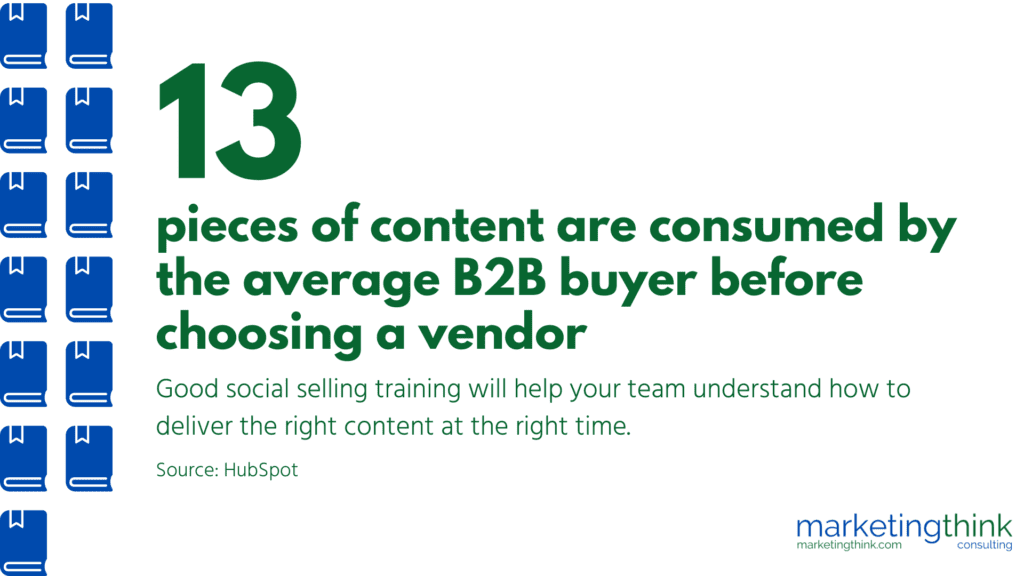You must know how to use social media to connect with B2B buyers and their buying teams. And I mean more than having a LinkedIn profile!
With B2B buying teams doing their own research and consuming more content than ever to help frame their problems and decide on vendors, most sales teams need some social selling schooling, for sure!
If you are unsure about that statement, look at these statistics to give you a reason to believe.
Reasons to Believe You Need Social Selling to Connect with B2B Buyers
- 45% of B2B buyers said that they use social media as a crucial part of their decision-making process, according to a survey conducted by Demand Gen Report.
- 76% of B2B buyers prefer to work with recommendations from their professional networks when making purchasing decisions, says another study by LinkedIn. These statistics indicate that social media can significantly influence B2B purchase decisions. Businesses should consider leveraging social media platforms to engage with their target audience and build relationships with potential buyers.
So, what can you learn from these simple statistics? This customer’s native behavior influences today’s selling and marketing lessons. They are learning and educating themselves using digital and social sources, with or without our help.
We’ve all had customers tell us they have narrowed their decision to a handful of vendors or products based on their research. Even worse, we’ve all received an ‘out-of-the-blue’ RFP, with all the needs and requirements neatly packaged into a PDF requiring our 5-day response. Do these experiences sound familiar?
- B2B buyers consume an average of 13 content pieces before deciding on a vendor. This statistic suggests that creating helpful content can help sellers effectively engage with potential customers and influence their purchasing decisions. Now that’s a social selling opportunity!

3-part Social-Selling Lesson Plan
We must avoid this self-education behavior and build a consulting relationship to help frame our customer’s problems.
1. Prove It With Teaching Credentials.
Make sure to walk the talk regarding credentials and reputation management. When customers raise their hands to learn, let’s ensure we have the teaching (vs. selling) cred to back up our ability to make a difference. We want to build up and document our reputation by:
- Maintain great customer-centric LinkedIn and Twitter profiles to show who we are and our history of helping.
- Regularly distribute valuable content and links. Use LinkedIn updates, tweets, blog posts, and comments to show we are keeping current with the customer-centric issues vs. just our product features and benefits.
- Participating in community and LinkedIn Groups discussions where our customers are searching to show we operate more like an insight-giving teacher instead of a feature-touting sales representative
This attention to reputation builds our credibility when we are ‘Googled.’
2. Have A Different Content Chapter For Each Stage In The Buying Journey.
Awareness, consideration, and purchase are the buying process stages. Once we’ve grabbed our customers’ attention, we need to map the conversation and content to the place in the buying stage. And we need to deliver the messaging on the customer’s digital and social channels of choice. B2B buyers continue to learn as they move closer to their decision, using more refined search terms as their research deepens. That’s where the role of account-based marketing and social media content comes into play. For example, as your team comes closer to closing a deal, your sellers should share third-party posts and articles that help your buyers decide.

3. Tutor Customers To Solve Their Problems.
Customers want to hear about real-life experiences and how others handled their situations. They want insight into solving their problems. A simple 3-question framework is a great place to begin the tutoring session.
- What is the problem?
- What does the problem mean to you?
- How can a solution and vendor help solve your problem?
Teaching the first two questions will help make the sale much easier to complete.
Can you teach us a thing or two about a lesson you taught a customer? If so, then please share in the comment section! Or, contact me directly at gerry@marketingthink.com.
Dave Edmonds from Rockpile said, “No one there to tell me how. A different world – teacher, teacher, teach me now.” It is a different world for all of us, so we need to teach our customers how to solve their problems.
So, be a social selling teacher and not a seller.

